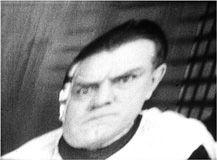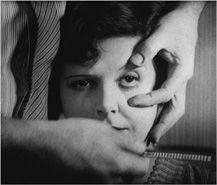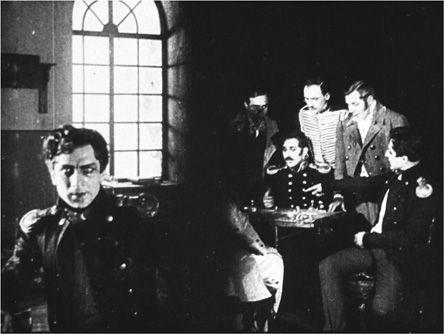B0041VYHGW EBOK (190 page)
Authors: David Bordwell,Kristin Thompson

Automatic writing and painting, the search for bizarre or evocative imagery, the deliberate avoidance of rationally explicable form or style: these became features of Surrealism as it developed in the period 1924–1929. From the start, the Surrealists were attracted to the cinema, especially admiring films that presented untamed desire or the fantastic and marvelous (for example, slapstick comedies,
Nosferatu,
and serials about mysterious supercriminals). In due time, painters such as Man Ray and Salvador Dalí and writers such as Antonin Artaud began dabbling in cinema, while the young Spaniard Luis Buñuel, drawn to Surrealism, became its most famous filmmaker.
Surrealist cinema is antinarrative, attacking causality itself. If rationality is to be fought, causal connections among events must be dissolved, as in
The Seashell and the Clergyman
(1928; scripted by Artaud, filmed by the Impressionist Germaine Dulac; see
(
12.26
).
In Dalí and Buñuel’s
Un Chien andalou
(
An Andalusian Dog,
1928) the hero drags two pianos, stuffed with dead donkeys, across a parlor. In Buñuel’s
L’Age d’or
(1930), a woman begins obsessively sucking the toes of a statue.

12.26
The Seashell and the Clergyman:
the clergyman’s distorted view of a threatening military officer, inexplicably dressed in baby’s clothes.
Many Surrealist films tease us to find a narrative logic that is simply absent. Causality is as evasive as in a dream. Instead, we find events juxtaposed for their disturbing effect. The hero gratuitously shoots a child (
L’Age d’or
), a woman closes her eyes only to reveal eyes painted on her eyelids (Ray’s
Emak Bakia,
1927), and—most famous of all—a man strops a razor and deliberately slits the eyeball of an unprotesting woman (
Un Chien andalou,
12.27
). An Impressionist film would motivate such events as a character’s dreams or hallucinations, but in these films, character psychology is all but nonexistent. Sexual desire and ecstasy, violence, blasphemy, and bizarre humor furnish events that Surrealist cinema employs with a disregard for conventional narrative principles. The hope was that the free form of the film would arouse the deepest impulses of the viewer. Buñuel called
Un Chien andalou
“a passionate call to murder.”

12.27 The shocking eye-slitting scene in
Un chien andalou.
The style of Surrealist cinema is eclectic. Mise-en-scene is often influenced by Surrealist painting. The ants in
Un Chien andalou
come from Dalí’s pictures; the pillars and city squares of
The Seashell and the Clergyman
hark back to the Italian painter Giorgio de Chirico. Surrealist editing is an amalgam of some Impressionist devices (many dissolves and superimpositions) and some devices of the dominant cinema. The shocking eyeball slitting at the start of
Un Chien andalou
relies on some principles of continuity editing (and indeed on the Kuleshov effect). However, discontinuous editing is also commonly used to fracture any organized temporalspatial coherence. In
Un Chien andalou,
the heroine locks the man out of a room only to turn to find him inexplicably behind her. On the whole, Surrealist film style refused to canonize any particular devices, since that would order and rationalize what had to be an “undirected play of thought.”
The fortunes of Surrealist cinema shifted with changes in the art movement as a whole. By late 1929, when Breton joined the Communist Party, Surrealists were embroiled in internal dissension about whether communism was a political equivalent of Surrealism. Buñuel left France for a brief stay in Hollywood and then returned to Spain. The chief patron of Surrealist filmmaking, the Vicomte de Noailles, supported Jean Vigo’s
Zéro de Conduite
(1933), a film of Surrealist ambitions, but then stopped sponsoring the avant-garde. Thus, as a unified movement, French Surrealism was no longer viable after 1930. Individual Surrealists continued to work, however. The most famous was Buñuel, who continued to work in his own brand of the Surrealist style for 50 years. His later films, such as
Belle de Jour
(1967) and
The Discreet Charm of the Bourgeoisie
(1972), continue the Surrealist tradition.
Following the Russian Revolution in October 1917, the new Soviet government faced the difficult task of controlling all sectors of life. Like other industries, the film production and distribution systems took years to build up a substantial output that could serve the aims of the new government.
During World War I, there were a number of private production companies operating in Moscow and Petersburg. With most imports cut off, these companies did quite well making films for the domestic market. The most distinctive Russian films made during the mid-1910s were slow-paced melodramas that concentrated on bravura performances by actors playing characters caught in extremely emotional situations. Such films showcased the talents of Ivan Mozhukin and other popular stars
(
12.28
)
and were aimed mainly at the large Russian audience, seldom being seen abroad.

12.28 In Yakov Protazanov’s 1916
The Queen of Spades,
the gambling-addicted hero, played by Mozhukin, imagines himself winning at cards, with his vision superimposed at the right.
These film companies resisted the move made directly after the Revolution to nationalize all private property. They simply refused to supply films to theaters operating under the control of the government. In July 1918, the government’s film subsection of the State Commission of Education put strict controls on the existing supplies of raw film stock. As a result, producers began hoarding their stock; the largest firms took all the equipment they could and fled to other countries. Some companies made films commissioned by the government, while hoping that the Reds would lose the Civil War and that things would return to pre-Revolutionary conditions.
In the face of shortages of equipment and difficult living conditions, a few young filmmakers made tentative moves that would result in the development of a national cinema movement. Dziga Vertov began working on documentary footage of the war; at age 20, he was placed in charge of all newsreels. Lev Kuleshov, teaching in the newly founded State School on Cinema Art, performed a series of experiments by editing footage from different sources into a whole that creates an impression of continuity. Kuleshov was perhaps the most conservative of the young Soviet filmmakers, since he was basically trying to systematize principles of editing similar to the continuity practices of the classical Hollywood cinema (
pp. 227
–228). Thus, even before they were able to make films, Kuleshov and his young pupils were working at the first film school in the world and writing theoretical essays on the new art form. This grounding in theory would be the basis of the Montage style.
In 1920, Sergei Eisenstein worked briefly in a train carrying propaganda to the troops in the Civil War. He returned that year to Moscow to produce plays in a workers’ theater. In May 1920, Vsevolod Pudovkin made his acting debut in a play presented by Kuleshov’s State Film School. He had been inspired to go into filmmaking by seeing Griffith’s
Intolerance,
which was first shown widely in Russia in 1919. American films, particularly those of D. W. Griffith, Douglas Fairbanks, and Mary Pickford, which kept circulating to fill the void left by the low output of new Soviet productions, were a tremendous influence on the filmmakers of the emerging Soviet movement.
None of the important filmmakers of the Montage style was a veteran of the pre-Revolutionary industry. All came from other fields (for example, Eisenstein from engineering and Pudovkin from chemistry) and discovered the cinema in the midst of the Revolution’s ferment. The Czarist-era filmmakers who remained active in the USSR in the 1920s tended to stick to older traditions. One popular director of the Czarist period, Yakov Protazanov, went abroad briefly after the Revolution but returned to continue making films whose style and form owed almost nothing to the theory and practice of the new filmmakers.
Protazanov’s return coincided with a general loosening of government restrictions on private enterprise. In 1921, the country was facing tremendous problems, including a widespread famine. In order to facilitate the production and distribution of goods, Lenin instituted the New Economic Policy (NEP), which for several years permitted private management of business. For film, the NEP meant a sudden reappearance of film stock and equipment belonging to the producers who had not emigrated. Slowly, Soviet production began to grow as private firms made more films. The government attempted, with little success, to control the film industry by creating a central distribution company, Goskino, in 1922.
“Everyone who has had in his hands a piece of film to be edited knows by experience how neutral it remains, even though a part of a planned sequence, until it is joined with another piece, when it suddenly acquires and conveys a sharper and quite different meaning than that planned for it at the time of filming.”
— Sergei Eisenstein, director
“Of all the arts, for us the cinema is the most important,” Lenin stated in 1922. Since Lenin saw film as a powerful tool for education, the first films encouraged by the government were documentaries and newsreels such as Vertov’s newsreel series
Kino-Pravda,
which began in May 1922. Fictional films were also being made from 1917 on, but it was not until 1923 that a Georgian feature,
Red Imps,
became the first Soviet film to compete successfully with the foreign films predominant on Soviet screens. (And not until 1927 did the Soviet industry’s income from its own films top that of the films it imported.)
The Soviet Montage style displayed tentative beginnings in 1924, with Kuleshov’s class from the State Film School presenting
The Extraordinary Adventures of Mr. West in the Land of the Bolsheviks
(
12.29
).
This delightful film, along with Kuleshov’s next film,
The Death Ray
(1925), showed that Soviet directors could apply Montage principles and come up with amusing satires or exciting adventures as entertaining as the Hollywood product.

12.29
The Extraordinary Adventures of Mr. West in the Land of the Bolsheviks:
a gang of thieves terrifies the naive American, Mr. West, by presenting him with clichéd caricatures of fierce Soviet revolutionaries.